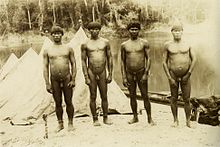Xingu peoples
 Mehinako Indians, ca. 1894 | |
| Total population | |
|---|---|
| 3,000 |
Xingu peoples are indigenous peoples of Brazil living near the Xingu River. They have many cultural similarities despite their different ethnologies. Xingu people represent fifteen tribes and all four of Brazil's indigenous language groups, but they share similar belief systems, rituals and ceremonies.
Precolumbian history[]
The Upper Xingu region was heavily populated prior to European and African contact. Densely populated settlements developed from 1200 to 1600 CE.[1] Ancient roads and bridges linked communities that were often surrounded by ditches or moats. The villages were pre-planned and featured circular plazas. Archaeologists have unearthed 19 villages so far.[2]
Post-contact history[]


Kuikuro oral history says Portuguese slavers arrived in the Xingu region around 1750. Xinuguano population was estimated in the tens of thousands but was dramatically reduced by diseases and slavery by Portuguese.[2] In the centuries since the penetration of the Europeans into South America, the Xingu fled from different regions to avoid the spread of deadly disease and enslavement by the Portuguese. By the end of the 19th century, about 3,000 natives lived at the Alto Xingu, where their current political status has kept them protected against foreign intruders. By the mid twentieth century this number had been reduced by foreign epidemic diseases such as flu, measles, smallpox and malaria to less than 1,000. Only an estimated 500 Xingu peoples were alive in the 1950s.[2]
The Brazilian Villas-Bôas brothers visited the area beginning in 1946, and pushed for the creation of the Parque Indígena do Xingu, eventually established in 1961. Their story is told in a film, Xingu. The number of Xingu living there in 32 settlements has risen again to over 3000 inhabitants, half of them younger than 15 years.
The Xingu living in this region have similar habits and social systems, despite different languages. Specifically, they consist of the following peoples: the Aweti, Kalapalo, Kamaiurá, Kayapó, Kuikuro, Matipu, Mehinako, Nahukuá, Suyá, Trumai, Wauja and Yawalapiti.
Notes[]
- ^ Hackenberger, Michael J. et al. "Amazonia 1492: Pristine Forest or Cultural Parkland?" Science Magazine. 25 July 2003 (retrieved 25 June 2011)
- ^ a b c Wren, Kathleen. "Lost cities of the Amazon revealed." 'NBC News' (retrieved 25 June 2019)
Further reading[]
Stenzel, Kris & Bruna Franchetto (eds.) (2017). On This and Other Worlds: Voices from Amazonia. Berlin: Language Science Press. ISBN 978-3-96110-018-7. doi:10.5281/zenodo.892102. Open access.
External links[]
- The Indians of the Xingu: Cultural Homogenization in the Amazon Rainforest
- A Report on the Xingu Peoples and the Land
- A Xingu case study, the Rainforest Action Network
- Xingu, on Povos indigenous no Brasil
- Xingu peoples
- Indigenous peoples in Brazil
- Indigenous peoples of the Amazon